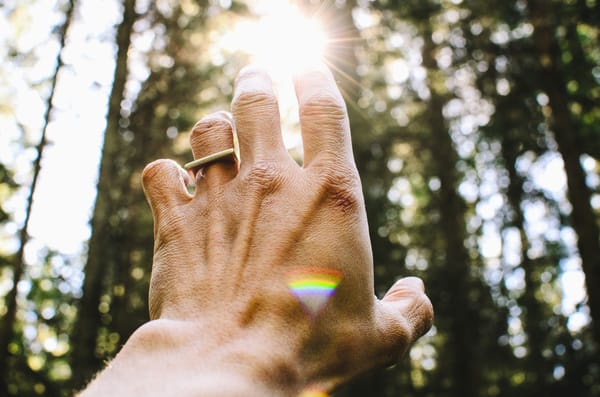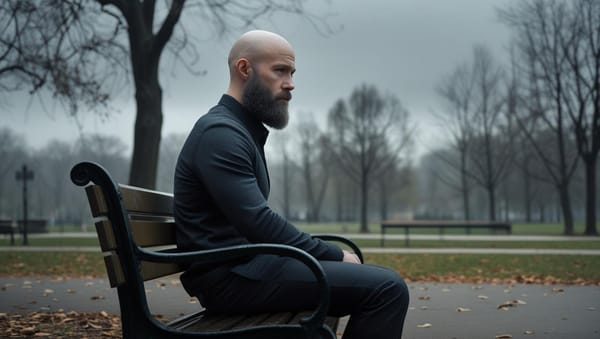The True Terror Lies in the Truth
The absolute terror isn't that evil exists somewhere out there in the darkness. It's that we've been living with it all along.

I remember holding my dad's hand, walking into our local Santikos theatre. I can still smell the buttery goodness of the popcorn and the sweat on the palms of my little hands. It was 1995, a weekend I was spending with my dad, and we were at the movies to see Halloween: The Curse of Michael Myers.
I was 9 years old and it was the first time I can remember going to the theatre to see a ‘scary movie.’ Though this was the first time I went to a theatre to see a horror film, it was a genre I was raised with since I could remember. As an even younger boy, I remember spending time at my aunt’s with my older brother and cousins while they watched Friday the 13th, Nightmare on Elm Street, and Creep Show. Being afraid and learning to face my fear was something I had to learn from a young age.
Around the same time, my older brother took me to a re-release of The Exorcist in theatres. Watching Linda Blair projectile vomit and have her head spin was the first time I remember feeling genuine terror. Being exposed to such fear and horror at such a young age, with the two men in my life that I trusted, created both a healthy fear and a curiosity of all things ‘scary.’
Learning to See the Message Behind the Medium
Throughout my childhood and well into my teens, it was common for me to watch classic horror films from the 1970s and 80s. The more I watched horror movies, the less the films scared me. In many cases, the cheesy acting and over-the-top ways people met their demise became humorous.
An unforeseen consequence of no longer being afraid of horror movies was that I began to see that often the writer of the film was using the genre to make a deeper point. Using a non-horror example, I’ve loved the original Robocop since it first came out. Most people don’t realize that Robocop isn’t simply an '80s action movie about a cyborg police officer restoring peace to Detroit. Instead, the movie is a critique of Capitalism. The film highlights the danger of corporate power, systemic corruption, neoliberal ideology, dehumanization, and media manipulation.
The film was such a pointed critique of capitalism that director Paul Verhoeven saw RoboCop as;
“An 'American Jesus' narrative that exposes the brutal mechanisms of unchecked capitalism.” (Trickle Down Robonomics — The Predatory Capitalism of Robocop)
As a child, I didn’t intuitively pick up that Robocop was a social commentary against the danger of laissez-faire capitalism. I was able to pick up that the movie was telling a story beyond being good guys defeating bad guys, but it took time and knowledge to develop the language to understand the more profound message.
The Monster that Attacks from Outside
A friend of mine in my early twenties was a significant fan of Asian horror films. Specifically, they loved Korean and Japanese horror. Every Friday night, he would invite a group to check out the latest movies.
Maybe because there was a language and cultural barrier, but watching these movies was the first time I picked up that horror could also be a commentary on society. Analyzing movies to understand the deeper point or message led me to watch horror movies I was raised watching with a fresh perspective.
Ask any horror fan, any true horror fan, what are the scariest movies of the 1970s, and they’ll consistently tell you: Halloween, Jaws, and The Exorcist. Halloween is about a person born of pure evil growing up to be a psychopathic serial killer in a small midwestern town. Jaws is about an apex predator attacking families on Spring Break at a small town in New York. The Exorcist is about a girl in Washington, D.C. who becomes possessed by a demon after playing with a Ouija board.
On the surface, these films have little to nothing in common. However, when we consider the more profound social commentary driving the horror narratives, we see that the movies are actually ‘eerily’ similar.
At the root of all three movies is an outsider who enters into an ideal American environment and, through violence, threatens the ‘American way’ of life. Don’t believe me? Let me explain.
Michael Myers goes to Haddonfield, Illinois, which is quintessential small-town America. Everyone knows everyone, no one locks their doors, and our protagonist is Laurie Stroud, the model ‘girl next door.’ Everything in Haddonfield is picture-perfect Fall Americana. There are two-story homes in the suburbs, wide streets, perfect shades of orange, yellow, and brown, and pumpkins on every porch. Nothing can go wrong in a place like Haddonfield…Unless an outside threat, Michael Myers, were to come and jeopardize this utopia.
In Jaws, we get the ideal American vacation destination. A beautiful beach, hot dogs on the grill, beers and bonfires, and good, wholesome family fun. Again, it’s a snapshot of an American ideal where nothing could go wrong, unless an outside threat were to appear. Where the external threat in Haddonfield is Michael Myers to the community, in Jaws, it's a great white shark that found a buffet on Amity’s beaches.
With The Exorcist, it's Pazuzu, an ancient Mesopotamian demon that possesses a sweet young girl. In all three films, the threat is external. To vanquish the monster, it requires our protagonists to go into the dark unknown, risk their lives, and face the beast. Only when the monsters have been run out of town (or a little girl) can life return to normal.
All three of these movies align with the American narrative that the only threat that can endanger our way of life is the outsider or the ‘other.’ Whether it's Indigenous people that stand in the way of settler colonial expansion, African Americans fighting for freedom from chattel slavery, communism during the McCarthy, Cold War years, or immigrants and the ‘radical left’, the danger is always perceived as external.
The Real Threat comes from Within…
Ironically, the most horrifying movie of the 1970s is none of the ones discussed above. The scariest movie is actually The Texas Chainsaw Massacre.
What makes this movie so terrifying is how it flips the belief that the threat to our way of life is an external one. You see, in Texas Chainsaw Massacre, the real danger doesn’t come from outside the community but from within. The antagonists in the film are the Sawyer Family, made up of a grandfather and his three grandsons. They’ve been residents in a small Texas town for generations. Where the family used to work in the industrial factories, they’ve all moved on, leaving the residents who couldn’t move with them living in squalor.
Grandpa Sawyer now runs a gas station that sells barbecue made of human flesh. One of his grandsons, known as Leatherface, butchers people with a chainsaw and uses the skin to create furniture (a la Ed Gein). As scary as the acts the family commits, the true terror is that the Sawyer family is as American as apple pie.
There isn’t anywhere to run from the Sawyers because they are one of us. In many ways, as more and more wealth and opportunity are concentrated in the hands of the few, we, the many, are the Sawyers.
Texas Chainsaw Massacre isn’t the only one highlighting the actual threat to our society, being an internal one. Today, films like Get Out, Us, Candyman, and Nope are director Jordan Peele’s picking up the mantel of using horror as social commentary.
With Halloween around the corner, the next time you sit down to watch a horror film, ask yourself: What is the true monster the director is trying to show me? The monster lurking in the shadows, or the smiling neighbor who waves while quietly resenting everything you represent? The demon that possesses the innocent, or the systems of power that devour communities while our leaders point fingers at borders and strangers? Horror is a unique medium that can use storytelling to show us our true monsters. The monsters that live among us don’t need to attack us from the shadows because we willingly subscribe to their podcasts, accept their selective memory as American history, and call their violence ‘manifest destiny’ and the will of God. The absolute terror isn’t that evil exists somewhere out there in the darkness. It’s that we’ve been living with it all along.





